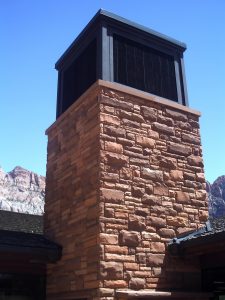 A solar chimney is also referred to as a thermal chimney, and as the name suggests, it makes use of passive solar energy to create convection of air and improve natural ventilation of a building. The solar chimney is not a new concept and has been in use of for centuries across the world. The passive solar heating and cooling system regulates the temperature of a building and provides ventilation. Essentially speaking, these chimneys are shaped like a hollow container that links the interiors of the building to the outside of the building.
A solar chimney is also referred to as a thermal chimney, and as the name suggests, it makes use of passive solar energy to create convection of air and improve natural ventilation of a building. The solar chimney is not a new concept and has been in use of for centuries across the world. The passive solar heating and cooling system regulates the temperature of a building and provides ventilation. Essentially speaking, these chimneys are shaped like a hollow container that links the interiors of the building to the outside of the building.
Describing the solar chimney in its simplest form
The solar chimney comprises of a black-painted chimney. The air within the chimney gets heated during the day. This creates an updraft of air in the chimney, and the suction at the base of the chimney is used to ventilate and cool the building. The solar chimney is especially useful on hot, windless days as it can easily provide ventilation.
Another proposal has been put forth for the principle of solar power generation, with the use of a huge greenhouse at the foundation, instead of relying on the heating of the chimney itself. Solar chimneys are painted black so as to absorb the maximum of the sun’s heat effectively.
However, there can be variations in the elements of the basic design of a solar chimney. For example, the solar collector area can be placed in the upper part of the chimney o it can be included in the entire shaft. The glazing, insulation and thermal properties of the solar collector part can be crucial for harnessing and using solar gains. The location, height, cross-section of the main ventilation shaft is also very important for the thermal properties. The size and location of the inlet and outlet air apertures are also important.
How a solar chimney works
Solar chimneys are a cheap and effective way to ventilate and heat a building. The chimney is coated with a dark colored material, preferably black so as to minimize any reflection of sunlight. The idea is to absorb maximum heat from the sun rays and transfer more heat to the air inside the building. The process of heating is fairly simple. When the solar radiation reaches the chimney, the air inside gets heated, and as the chimney vents are closed, the heated air is pushed back and downward and thus moved towards the living space. A type of convective air heating is provided, and as the air cools, it gets sucked back in the solar chimney, to get heated once again.
Benefits of using solar chimney
The solar chimney is an excellent way to benefit natural ventilation and passive cooling strategies of buildings. There is the lower use of energy and reduced CO2 emissions and pollution. Potential benefits of solar chimneys and the natural ventilation can help improve ventilation rates and lower the reliance on wind driven ventilation. There is an improved control of air flow and air quality within the building. There is an increased rate of night time ventilation and cooling.
